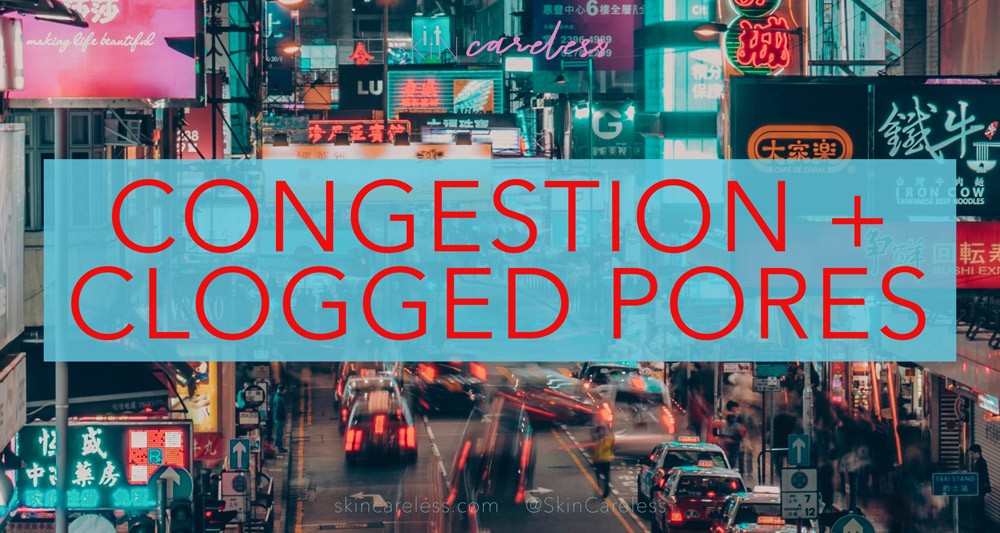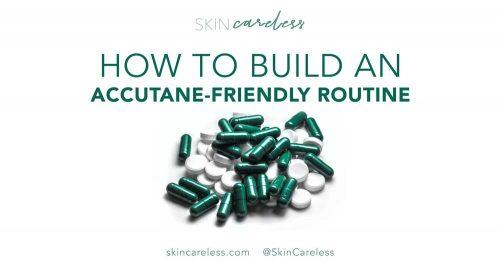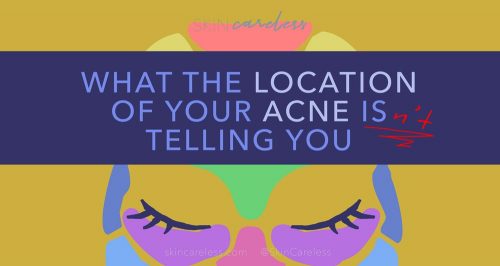Have you ever taken the time to think why you’re doing all that preening and purchasing? Is it in search of perfect skin? What would your real ‘goal skin’ would even look like?
I want you to really think for a minute. Close your eyes.
I bet I can guess exactly what you’re seeing.
You’re picturing skin so smooth it’s practically reflective. Not a speck of texture in sight. You practically glow in the light.
But hey, why is it that your skin doesn’t look like that? If you dislike the look and texture of your skin but you don’t yet suffer from wrinkles and ageing, what gives?
It’s likely you, like millions of others, suffer from congestion. Thankfully it’s something you can manage and even eliminate with the right products and techniques.
How to recognise if you have congested skin
You’ve probably heard the term before – but what does congested skin look like?
Congestion looks like tiny skin coloured bumps, especially on the forehead and chin, but can appear anywhere. When you shine a light on your skin, it might look bumpy and dull. Running your fingers over congestion, it feels textured and uneven. These irregularities not usually very red at all, and they are STUBBORN.
Congestion is incredibly common and one of the main concerns people have with their skin – especially teens and young adults! Just to confuse you, it’s also often called clogged pores and sometimes closed comedones.
What even is congestion?
Congested skin is skin that has trouble healthily expelling sebum, forming a cycle of acne and dullness.
You definitely know by now that everyone’s skin is covered in thousands of tiny pores, which contain a baby-fine hair strand and an oil gland.
With congestion, oil trying to leave the pores to lubricate and protect the surface of your skin becomes blocked for one of several reasons. The pore swells as the trapped oil and whatever debris such as makeup, dead skin and dirt all sit in the pore and become more solid as time passes.
Think of it as ‘plugged up’ skin. Like when you’re congested from a cold and you have a hard time coughing out the debris, congested skin is packed full of stuff it doesn’t need but can’t get rid of.
Congestion is non-inflamed, so it isn’t sore or red, but once it’s there it won’t go away without our help.
Contributing factors to congested skin
But why are you the unlucky one who has to suffer from congestion? There are tons of ways the skin can become blocked and things that contribute to bad congestion.
Anything that affects the contents or behaviour of the pore can bring about congestion. The two main issues are things that cause the pores to fill up, and those that affect the pore opening.
Anything that interrupts the smooth flow of sebum from pore to surface can cause the pore to fill. This is most often changes to the consistency of the natural skin oils, however it could also be other debris that integrates with the pore’s contents.
- Oily skin – too much oil = more likelihood of clogs
- Hormones – these change the consistency of sebum
- Heavy exercise – sweating can increase likelihood of infection
- Environmental factors – pollution infiltrates the skin
- Improper cleansing – left over skin cells, makeup, and dirt
Anything that changes the ability for our pores to be reached by cleansers and products risks worsening congestion. These could be:
- Excess dead skin cells – Besides not enough exfoliation in your routine, there’s a number of reasons your skin might not be exfoliating itself enough naturally. These include bad lifestyle habits and the natural ageing process.
- Inflammation – If you suffer from a condition like dermatitis or psoriasis, or have otherwise irritated and inflamed skin, this can block pores. Swelling narrows the pore opening and contributes to more congestion.
- Heavy makeup – Again, thick and cakey makeup can physically block the pore opening.
What can congestion lead to?
Congestion isn’t a serious problem on its own as it can be pretty subtle. But serious congestion that’s left untreated can lead to:
Non-inflamed and inflamed acne
Congestion is a stepping stone to acne. A badly congested pore is called a closed comedone. If the pore is blocked and the flow of oil is disrupted somehow, it’s the perfect environment for bacteria to multiply as they love an anaerobic (oxygen-free) and oil-rich environment. Once pores become infected this leads to the more traditional blackheads and whiteheads, or even inflammatory and cystic acne. These kinds can cause long-lasting scarring and pigmentation.
Dryness & dehydration
It makes sense that if you have chronic congestion, all that oil that should be coming through the pores is unable to make it through. The surface of the skin will dry out and leave you susceptible to dehydration and sensitivity.
The best skin care products for congested skin
Now you know congestion is a blockage in the pore, the obvious way to reduce congestion and finally smooth out your skin is to dissolve that blockage! The approach involves freeing the pore and loosening the contents.
- Physical exfoliants – these clear the blockage at the surface, often releasing the congestion and allowing it to be more effectively treated.
- Masks – great at removing excess oil and so help your next products penetrate better.
- Salicylic acid products – this breaks through oil and debris to reduce swelling and bacterial activity. This is the wonder product for clearing non-inflamed acne.
Plan of attack – Congestion clearing routine
It’s not only about the products and ingredients you use, but how you use them. Here’s the full at-home routine you should do right now to help reduce congestion starting tonight. Please note: Consider this the ‘kill it with fire’ approach, and be very cautious about overdoing it. If your skin begins to look dry or irritated, dial it back!
The routine is:
Exfoliate – mask – salicylic – oil massage – cleanse
To start, gently physically exfoliate to free the pore. I suggest Konjac sponges, microfibre cloths, or the Clarisonic.
Then apply a clay mask to dry out the surface of the skin and allow the products to penetrate more easily.
Then, apply your chosen salicylic acid product and leave to set for 15 minutes, allowing it to break down the sebum and debris in the pore and reduce any inflammation.
After this, apply a carrier or cleansing oil and (very) gently massage this over your problem areas. You’re trying to soften and coax out the sebum that the salicylic acid loosened. Keep this up for 5 minutes.
Finally, cleanse as normal to remove the oil and complete the double cleanse.
For the rest of the week, repeat the oil massage nightly before cleansing. Incorporate salicylic acid every other day if you’re new to it, or every day if your skin can already handle it.
Next week: do another round of the exfoliate – mask – salicylic – oil massage – cleanse routine, followed by 6 days of double cleansing with oil followed by a regular cleanser. Repeat this routine weekly as you see fit!
When nothing else helps – Professional congestion treatments
For really stubborn congestion that doesn’t respond to at home treatment, there are more expensive yet very effective aesthetician options.
Hydrafacial
I have a whole review on the process and reasoning behind the hydrafacial, but to summarise, it’s a physical and chemical exfoliation combo followed by hydrating serums. Consider it the all-in-one facial to get your skin back on track. If you’ve slacked off your routine a bit and need a little push back in the right direction, this is it!
Chemical peels
Especially great for stubborn congestion, a professional series of peels will encourage healthier skin cell production, smooth your skin’s texture, and best of all reduce the likelihood for congestion to set in.
Extractions
By tackling bigger closed comedones, milia or just stubborn blackheads, extractions can help take the edge of congested skin so you can get everything else under control at home.
Dermatologist advice
A doctor may need to step in and assess your skin if nothing else works. You may be suffering from a hormonal imbalance or other issue causing chronic, severely congested skin. Consider whether your situation calls for professional help.
Can your diet affect congestion?
In general, your diet will not cause congestion in any significant way that makes changing it an effective treatment. Of course a healthy diet will support the skin to be the best it can be, but it’s not as easy and just removing deep-fried foods or increasing carbs.
The exception to this might be dairy. Many people report adverse hormonal effects from dairy, leading to hormonal jawline congestion. If nothing else works, try skipping the cereal for a month and see if it makes a difference for you.
Keeping congestion at bay long-term
What about once (cross fingers) you beat your congestion for good? Beyond the routine above, there are a couple of things to remember to stop yourself getting back into the same position again.
- Wash after exercising
- Keeping the sweat to the gym and cleaning it off ASAP will prevent a myriad of skin issues. Use something gentle like micellar if you exercise during the day.
- Avoid heavy products
- Anything that’s simply too rich for you can incite whiteheads and congestion. Be sure to cater your skin care to the season and your skin type.
- Proper makeup removal
- Removing excess product and oil and bacteria it clings on to from the day is key to discouraging congestion.
- Reduce oil production
- Avoid over stimulating the skin by using rough or drying products, and consider doctor’s help if the issue is hormonal or severe.
I hope that this offers you some relief from congestion in your skin. I know I’ll struggle with skin issues like this indefinitely, but doing something about it has definitely improved how I feel about the way I look!






[…] skin issues because we want to get rid of a skin problem. When the issue is textural – like closed comedones beneath the skin that won’t come out – the idea is that your new routine or new product […]
[…] tested to adhere to skin’s pH and deliver effective ingredients to tackle certain issues like congestion or cystic acne to where they need to be in a safe and gentle manner. They can remain on your skin […]